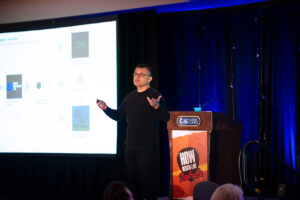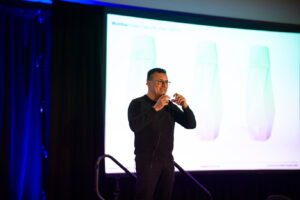 Gerardo Herrera had questions.
Gerardo Herrera had questions.
When generative AI suddenly sprang into the mainstream, the director of packaging design at Art Center College of Design wondered what the heck was going on: How would it affect him? How would it change the way he worked? How would it change the field at large?
So, he dove in headfirst and got his hands dirty. And as he did, another question rose to the surface: How, exactly, was he going to teach his students to be ready for all this? After all, they were (justifiably) freaked out by the development encroaching on a profession they hadn’t even officially entered yet.
“My students were saying, ‘Gerardo, I’m scared about this.’ I go, ‘Yes—but let’s learn about this.’”
And that’s exactly what they did, and what the audience did as well at Herrera’s HOW Design Live 2023 session, “Exploring the Intersection of AI, Design and Packaging: Insights and Techniques”—a fascinating talk driven by his experiments with the field’s top AI programs.
It proved to be one of the highest-ranked sessions from the entire event—and here we bring you our top takeaways and tips for getting started with AI and besting the brave new world before us.
- Set your fears aside.
People have gotten over, say, their fear of flying by digging into the mechanics of how planes work. So, first things first: Dive into AI headfirst, like Herrera did. Once you understand what these programs do and are capable of, you’re likely to find a measured drop in your anxiety—and, just maybe, a new virtual collaborator in the process.
- Make sure you’re street legal.
Official policies around AI are in their early stages—your company may have one, and it may not. Herrera recommends checking in with legal as early as possible if you’re going to utilize any AI in your formal design work, especially as it pertains to crediting the programs at hand.
- Assess your workflow.
As he stepped back and took a look at his design process, Herrera saw an opportunity for AI to function as a sort of assistant in creating mood boards and developing characters, packaging elements, and more. Where might AI fit into your workflow?
“If you’re by yourself, this is perfect,” he said in his talk. “Think of it as Jarvis and Tony Stark working together. You can spitball ideas.”
- Keep your prompts simple and build on them.
The key to all AI design work is the prompts—the written text you feed in to get your visual output back. Herrera recommends starting small. For one project he asked for a plain white cosmetic tube, but the results weren’t exactly what he was seeking. So, he redid the prompt to ask for a plain white cosmetic tube with no identifying marks or type, on a white background, shot with overhead light—and he got just what he wanted: a mockup he could play with. In our experience, it’s easier to add and build upon prompts in layers than it is to parse out elements down the line.
- Don’t forget that your real-world training is your best asset.
While it may seem like designs emerge magically from the ether of AI programs, it’s all driven by your background and expertise. It’s art direction. So put your design skills and knowledge to work. Use the body of references and cues that you’ve mentally accrued over the years. Break out sizes and highly specific packaging terms. Tell the AI how you want your subject lit, and by what type of light. Tell it how you want the subject photographed (and by what type of camera). Use everything in your foundation to make it give you the results you’re seeking.
- Experiment with the different options out there.
Herrera said all of the AI programs are based on different datasets, so the top three options—Midjourney, DALL-E and Stable Diffusion—all yield different results. Midjourney, for instance, is very expressive. They all have their own prompt language to drive output, so experiment and see what works best for you and the aesthetic you’re seeking. Herrera also recommends designers get up to speed with Firefly as soon as they can: “Adobe is doing it right.”
- Let it surprise you.
AI can throw some unexpected things your way—and that’s a good thing, especially if you’re a solo creative working in a vacuum. As Herrera was experimenting on a concept, the AI included some trucks in an image, something he said he would have not thought to do. Through the course of inputting prompts, he has also come across elements like textures and materials that he has utilized in his work.
- Don’t forget about the real world.
Herrera uses AI programs not just to concept for himself, but for those he’s collaborating with as well. So, he can conjure up an idea in a program and nail down the angles and overall aesthetic he’s seeking—and then share it with a photographer he’s commissioning to play off of it.
Ultimately, a careful balance like this may be the key to a fruitful future for both designers and their virtual counterparts alike.
Watch Herrera’s AI work in real time—and for some advanced techniques for working with the industry’s leading programs.
For information on Gerardo Herrera click here.
